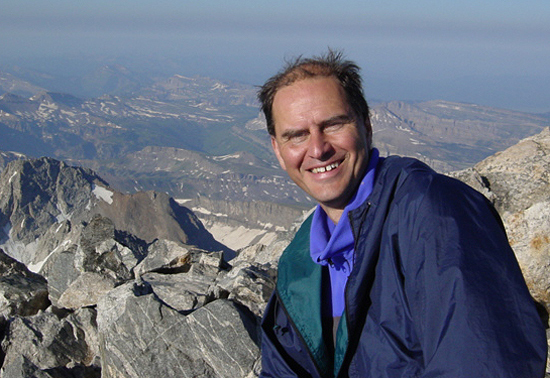Adjunct Professor of Music Helps Students Create Music Here and Online
 |
| Ronald Kuivila, ’77, adjunct professor of music, smiles from the Grand Teton in Wyoming. |
| Posted 02/23/05 |
|
Q: When did you join the Music Department at Wesleyan? A: I joined the department as an artist in residence in the early 80s and converted to adjunct associate professor in the early 90s. As an artist in residence, I was expected to teach three courses a year and maintain an active professional profile as an artist and composer. As an adjunct professor, I am expected to teach four courses a year, participate in committee work, and maintain an active professional profile. Most of the adjunct faculty in the Music Department began as artists in residence. Q: What do you consider yourself, musically, to be an expert on? A: Live electronics, computer music systems, sound installation and American experimental music. I am also a mediocre pianist. Q: Can you tell me a bit about your educational background and what led you into teaching music? A: I was a Wesleyan undergraduate and I came to Wesleyan with an interest in experimental music. In fact, it was a video tape of Nam June Paik’s that featured Alvin Lucier that led me to apply to Wesleyan in the first place. After Wesleyan, I studied at Mills College, worked as a recorded engineer and was an artist in residence at Media Study/Buffalo and a creative associate at Center for the Creative and Performing Arts at SUNY Buffalo. Q: You came to Wesleyan with an interest in experimental music, and now youre also director of the electronic music and recording studios. Tell me about the studio, and what you can produce here. A: There are two studios, a recording booth connected to two large recording studios that double as classrooms and rehearsal spaces and an electronic music studio. The studios are used for recording and producing student and faculty work. Much of the work we do in the electronic music studio takes the form of interactive systems and live electronics using various kinds of software and hardware. Q: Can you give me a project example? A: A particular focus is SuperCollider, a programming environment for computer music that is now distributed as free software. SuperCollider is being developed by a number of programmers located throughout the world through SourceForge, the largest open source software development site in the world. My own work with SuperCollider has been primarily focused on my own work and making tools that enable students to be able to develop pieces quickly. However, I recently provided a nerdier contribution by optimizing SuperCollider’s primary score library. Q: In addition to your work on SuperCollider, I understand that youre an active composer and scholar? A: This last year I have been doing more work as a scholar and curator. The most recent number of Leonardo Music Journal has an article of mine on the work of the composer and pianist David Tudor together with a CD of his work that I edited. Last spring I curated a group exhibition of sound works at the gallery Art in General in Tribeca. Most recently, a piece I made in collaboration with Ed Tomney was presented in New York City and a piece made while I was a composer in residence at the Center for Contemporary Music at Mills College was presented in Oakland, California. Q: Do you give presentations on your work and music? A: As anyone who knows me will verify, I like to talk. Over the last year, I have given talks and participated in panels at the Getty Research Institute, the art department at Stanford University, the music department at Harvard, the great hall at Cooper Union in New York City and at Columbia University. Q: How would you describe the musically-inclined students at Wesleyan. Where do these students end up working if they stick with a music degree? A: Music students at Wesleyan are an extremely varied group. The only attributes they all seem to share are keen interest and intelligence. Students of mine have gone to graduate programs at RPI, the Art Institute of Chicago, Cal Arts, Mills College, SUNY Stony Brook, the Baden-Wurttemburg exchange program. Some are teaching, some are in the media industry, some are in the music software industry, some are pursuing careers in Europe and the U.S. Q: Whats a typical day like for you here in the Music Department? A: Normally, I teach two classes, run a group tutorial and individual thesis tutorials with undergraduate and graduate students. I also organize an annual festival of new and experimental music. One project in last year’s festival involved replacing the light classical muzak that emanates from the parking garage near Main Street with projects developed by students in my class. Q: Outside of work, what do you like to do? Does it involve music? A: Along with music, I love cooking. Many composers are also good cooks! I also enjoy sports such as skiing, hiking, swimming and squash. I am a particularly bad squash player. I do some mountain climbing. Two years ago I climbed the Grand Teton with a friend and a guide. Q: Is your family into music, too? A: Actually, this is my most important project. During Valentine’s Day 2003, my wife, Bobbi, and I returned from China with our newly adopted daughter, Cai. Cai is definitely musically oriented. In the grocery store, she managed to get a crowd staring up at the speaker in the ceiling by pointing at it and saying, music. |
| By Olivia Drake, The Wesleyan Connection editor |

